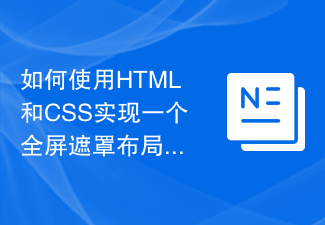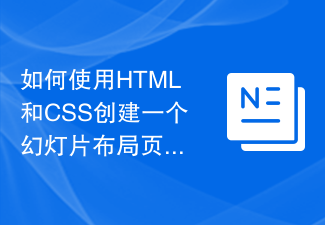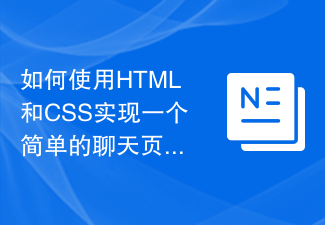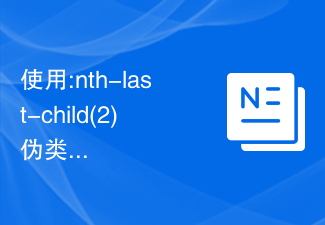 Web Front-end
Web Front-end HTML Tutorial
HTML Tutorial HTML layout guide: How to use pseudo-class selectors for table style control
HTML layout guide: How to use pseudo-class selectors for table style control
HTML Layout Guide: How to use pseudo-class selectors for table style control
Introduction:
HTML tables are one of the commonly used elements in web design. for displaying data and information. However, by default, the style of a table can be relatively simple and uninteresting. To make the table more attractive, we can use CSS to control the style of the table. This article will introduce in detail how to use CSS pseudo-class selectors to control table styles, including specific code examples.
- What is a pseudo-class selector?
In CSS, a pseudo-class selector is a special selector used to select HTML elements. They are used to select elements in a specific state. Common pseudo-class selectors are:hover(select when the mouse is hovering),:active(select when activated) and:visited(visited link selection) etc. We can use pseudo-class selectors to control the style of table elements in specific states. - Table style control example
Let us use an example to demonstrate how to use pseudo-class selectors to control the style of a table. We will use the following HTML code to create a simple table:
<table>
<tr>
<th>姓名</th>
<th>年龄</th>
<th>性别</th>
</tr>
<tr>
<td>张三</td>
<td>25</td>
<td>男</td>
</tr>
<tr>
<td>李四</td>
<td>30</td>
<td>女</td>
</tr>
<tr>
<td>王五</td>
<td>35</td>
<td>男</td>
</tr>
</table>Now, we will use pseudo-class selectors to control the background color and text color of the table rows on mouseover. This can be achieved using the following CSS code:
table {
border-collapse: collapse;
width: 100%;
}
th, td {
text-align: left;
padding: 8px;
}
tr:hover {
background-color: #f2f2f2;
color: #000;
} In this example, we set the width of the entire table to 100% and merge the borders using the border-collapse property. The th and td elements are set to left-aligned and have some padding. Most importantly, we use the pseudo-class selector :hover to select table rows and change the background color and text color on mouse hover.
- Other commonly used pseudo-class selectors
In addition to:hover, there are other commonly used pseudo-class selectors that can be used to control the style of the table. Here are some examples:
-
:first-childSelect the first child elementtr:first-child { font-weight: bold; } -
:last-childSelect the last child elementtr:last-child { background-color: #f2f2f2; } -
:nth-childSelect the child element at a specific position, which can be set using the parameter n Intervaltr:nth-child(2n) { background-color: #f2f2f2; }
- Comprehensive example
Here is a more comprehensive example that uses a combination of pseudo-class selectors and other style attributes to complete the style of the table:
table {
border-collapse: collapse;
width: 100%;
}
th, td {
text-align: left;
padding: 8px;
}
tr:nth-child(even) {
background-color: #f2f2f2;
}
tr:hover {
background-color: #ddd;
color: #000;
}
th {
background-color: #4CAF50;
color: white;
}In this example, we use tr:nth-child(even) to select even rows and set the background color for them. :hoverPseudo-class selector is used to set the background color and text color when the mouse is hovering. The th element uses other style attributes to set the background color and text color.
Conclusion:
By using CSS pseudo-class selectors, we can easily control and customize the style of HTML tables. Whether it's via mouseover, or via a child element at a specific location, we can use pseudo-class selectors to add detail and beauty. I hope this article can provide you with a guide so that you can better use pseudo-class selectors to control table styles in HTML layout.
Reference:
- MDN Web Docs - Pseudo-classes: https://developer.mozilla.org/en-US/docs/Web/CSS/Pseudo-classes
The above is the detailed content of HTML layout guide: How to use pseudo-class selectors for table style control. For more information, please follow other related articles on the PHP Chinese website!
 如何使用HTML和CSS实现一个全屏遮罩布局Oct 20, 2023 pm 03:46 PM
如何使用HTML和CSS实现一个全屏遮罩布局Oct 20, 2023 pm 03:46 PM实现全屏遮罩布局是网页设计中常见的需求之一,能够给网页增添一种浓厚的神秘感和独特的效果。在本文中,将使用HTML和CSS来实现一个简单的全屏遮罩布局,并给出具体的代码示例。首先,让我们来创建HTML结构。在HTML文件中,我们会使用一个div元素来作为遮罩的容器,并在其中添加内容,如下所示:<!DOCTYPEhtml><html>
 如何使用HTML和CSS创建一个幻灯片布局页面Oct 16, 2023 am 09:07 AM
如何使用HTML和CSS创建一个幻灯片布局页面Oct 16, 2023 am 09:07 AM如何使用HTML和CSS创建一个幻灯片布局页面引言:幻灯片布局在现代web设计中被广泛使用,在展示信息或图片时具有很大的吸引力和交互性。本文将介绍如何使用HTML和CSS创建一个幻灯片布局页面,并提供具体的代码示例。一、HTML布局结构首先,我们需要创建一个HTML布局结构,包含一个幻灯片容器和多个幻灯片项。代码如下所示:<!DOCTYPEhtml&
 如何使用HTML和CSS实现一个简单的聊天页面布局Oct 18, 2023 am 08:42 AM
如何使用HTML和CSS实现一个简单的聊天页面布局Oct 18, 2023 am 08:42 AM如何使用HTML和CSS实现一个简单的聊天页面布局随着现代科技的发展,人们越来越依赖于互联网来进行沟通和交流。而在网页中,聊天页面是一种非常常见的布局需求。本文将向大家介绍如何使用HTML和CSS来实现一个简单的聊天页面布局,并给出具体的代码示例。首先,我们需要创建一个HTML文件,可以使用任何文本编辑器。以index.html为例,先创建一个基本的HTML
 HTML布局指南:如何使用浮动元素实现多栏布局Oct 27, 2023 pm 03:24 PM
HTML布局指南:如何使用浮动元素实现多栏布局Oct 27, 2023 pm 03:24 PMHTML布局指南:如何使用浮动元素实现多栏布局浏览网页时,我们常常会看到由多栏组成的布局,例如新闻网站的首页,产品展示页等。这种多栏布局通过将内容划分为多个列,并将它们并排展示,使得网页更加有序和美观。在HTML中,我们可以使用浮动元素来实现这样的多栏布局。本文将向您展示如何使用浮动元素来实现多栏布局,并提供具体的代码示例。基本概念在使用浮动元素实现多栏布局
 如何使用HTML和CSS实现一个详细页面布局Oct 20, 2023 am 09:54 AM
如何使用HTML和CSS实现一个详细页面布局Oct 20, 2023 am 09:54 AM如何使用HTML和CSS实现一个详细页面布局HTML和CSS是创建和设计网页的基础技术,通过合理使用这两者,我们可以实现各种复杂的网页布局。本文将介绍如何使用HTML和CSS来实现一个详细页面布局,并提供具体的代码示例。创建HTML结构首先,我们需要创建一个HTML结构来放置我们的页面内容。以下是一个基本的HTML结构:<!DOCTYPEhtml&g
 如何使用HTML和CSS创建一个响应式卡片墙布局Oct 25, 2023 am 10:42 AM
如何使用HTML和CSS创建一个响应式卡片墙布局Oct 25, 2023 am 10:42 AM如何使用HTML和CSS创建一个响应式卡片墙布局在现代网页设计中,响应式布局是一项非常重要的技术。通过使用HTML和CSS,我们可以创建一个响应式的卡片墙布局,以适应不同屏幕尺寸的设备。下面将详细介绍如何使用HTML和CSS创建一个简单的响应式卡片墙布局。HTML部分:首先,我们需要在HTML文件中设置基本结构。我们可以使用无序列表(<ul>)和
 HTML布局技巧:如何使用定位布局进行页面绝对定位控制Oct 19, 2023 am 08:40 AM
HTML布局技巧:如何使用定位布局进行页面绝对定位控制Oct 19, 2023 am 08:40 AMHTML布局技巧:如何使用定位布局进行页面绝对定位控制在Web开发中,页面布局是一个非常关键的要素。定位布局是一种常用的布局方式,可以让开发者更加灵活地控制元素在页面中的位置。本文将介绍如何使用定位布局进行页面绝对定位控制,并提供具体的代码示例。一、定位布局概述定位布局是指根据元素的位置属性来决定元素在页面中的位置。在CSS中,主要有三种定位方式:相对定位、
 使用:nth-last-child(2)伪类选择器选择倒数第二个子元素的样式Nov 20, 2023 am 11:22 AM
使用:nth-last-child(2)伪类选择器选择倒数第二个子元素的样式Nov 20, 2023 am 11:22 AM使用:nth-last-child(2)伪类选择器选择倒数第二个子元素的样式,需要具体代码示例在CSS中,伪类选择器是一种非常强大的工具,可以用来选择文档树中特定的元素。其中之一就是:nth-last-child(2)伪类选择器,它可以选择倒数第二个子元素并对其应用样式。首先,让我们来创建一个示例HTML文档,以便我们可以在其中使用这个伪类选择器。以


Hot AI Tools

Undresser.AI Undress
AI-powered app for creating realistic nude photos

AI Clothes Remover
Online AI tool for removing clothes from photos.

Undress AI Tool
Undress images for free

Clothoff.io
AI clothes remover

AI Hentai Generator
Generate AI Hentai for free.

Hot Article

Hot Tools

ZendStudio 13.5.1 Mac
Powerful PHP integrated development environment

SAP NetWeaver Server Adapter for Eclipse
Integrate Eclipse with SAP NetWeaver application server.

EditPlus Chinese cracked version
Small size, syntax highlighting, does not support code prompt function

DVWA
Damn Vulnerable Web App (DVWA) is a PHP/MySQL web application that is very vulnerable. Its main goals are to be an aid for security professionals to test their skills and tools in a legal environment, to help web developers better understand the process of securing web applications, and to help teachers/students teach/learn in a classroom environment Web application security. The goal of DVWA is to practice some of the most common web vulnerabilities through a simple and straightforward interface, with varying degrees of difficulty. Please note that this software

Atom editor mac version download
The most popular open source editor





